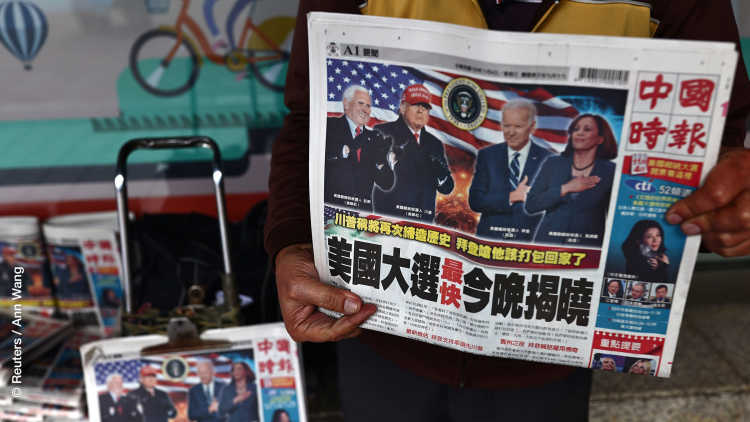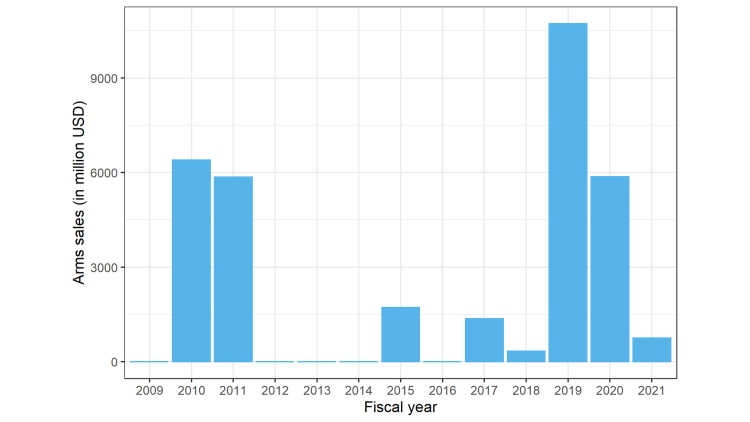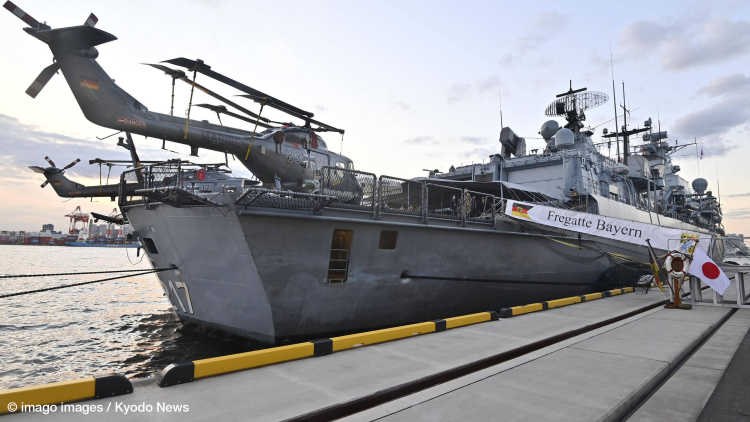- Home
- Publications
- GIGA Focus
- Managing the Status Quo: Continuity and Change in the United States’ Taiwan Policy
GIGA Focus Asia
Managing the Status Quo: Continuity and Change in the United States’ Taiwan Policy
Number 6 | 2021 | ISSN: 1862-359X

President Donald Trump’s departure from the White House was greeted with some concern in Taiwan. Having welcomed his confrontational stance towards China, many Taiwanese were concerned that US–Taiwan relations would worsen under President Joe Biden. The first 10 months in office, however, have seen the new administration repeatedly signal the US’s continuing support while committing to maintaining the status quo across the Taiwan Strait.
As part of Trump’s confrontational China policy, US–Taiwan relations saw a substantial upgrade under his leadership, both symbolically as well as in terms of concrete policies. This led many in Taiwan to view Trump as a true supporter.
In contrast, Biden was initially perceived as being “soft on China.” Once in office, however, the Biden administration has continued to show its self-declared “rock solid” support for Taiwan. Alongside symbolic gestures, this includes increased non-official relations and military cooperation, as well as measures to internationalise the “Taiwan question.”
In response, public opinion in Taiwan has considerably warmed towards Biden over the first 10 months of his presidency. At the same time, Chinese president Xi Jinping has intensified calls for Taiwan’s unification with the mainland while the People’s Liberation Army has ramped up military operations. This has further amplified Taiwanese rejection of Xi’s goal of “peaceful unification” under Beijing’s rule.
Policy Implications
As an element of the US’s geostrategic rivalry with China, Taiwan will continue to play an important role in Biden’s foreign policy. Because the participating actors’ diametrically opposed interests are unlikely to change in the foreseeable future, the Taiwan question will have to be managed carefully. The threat of violent clashes is real. Consequently, a balanced US and European policy should aim at maintaining the status quo in the Taiwan Strait, clearly signalling opposition to attempts at isolating Taiwan while also upholding the “One-China” policy.
Signals of Change while Maintaining the Status Quo
On 21 October 2021, during a townhall meeting hosted by the news network CNN, a college student asked President Joe Biden whether the United States would use military force to defend Taiwan against an attack by the People’s Republic of China (PRC). The president answered in the affirmative. Visibly surprised, CNN moderator Anderson Cooper repeated the question, to which Biden repeated his unexpected answer. A notable change in tone from previous administrations’ language when addressing US policy towards Taiwan, which since 1979 had adhered to the concept of “strategic ambiguity,” seemed afoot. The US had hitherto committed to supporting Taiwan’s ability to defend itself, inter alia by selling advanced weaponry, but not to using its own military to defend Taiwan while simultaneously not ruling that possibility out either. Biden’s answer was thus remarkable, even though high-ranking administration officials – including Secretary of State Anthony Blinken and Secretary of Defense Lloyd Austin – made sure to stress that US policy towards Taiwan had not changed and that the North American country would not unilaterally alter the status quo in the Taiwan Strait.
Nonetheless, a change in the public position on Taiwan seems to have been signalled. As vice president under President Barack Obama and in the early days of his own candidacy, Biden had emphasised the importance of cooperative engagement with China. This contrasted sharply with President Donald Trump’s approach to US–Taiwan relations, which had seen a substantial upgrade during his time in office. This led many in Taiwan to view Trump as a genuine supporter. Consequently, and different from most other countries in the region and worldwide, in Taiwan his departure from the White House was not greeted with a sigh of relief. Instead, many Taiwanese were worried about the potential worsening of US–Taiwan relations under Biden, who was speculated to be “soft on China.”
How, then, does Biden’s Taiwan policy differ from that of his predecessor? How has Biden’s stance evolved over time? And, what do Taiwanese citizens think of the current president?
US Taiwan Policy under Trump
In 1979, the US under President Jimmy Carter recognised the PRC as the sole representative of China and, thus, terminated official relations with Taiwan. Since then, political and military ties between the two countries have been defined by the 1979 Taiwan Relations Act (TRA). Politically, the TRA ensures that despite not officially recognising Taiwan as a sovereign state de jure, unofficial but de facto state-to-state “commercial, cultural, and other relations between the people of the United States and the people on Taiwan [can be maintained].” Moreover, the Act implies that US presidents cannot unilaterally revise US–Taiwan relations without Congressional approval. Militarily, the Act stipulates that “the United States will make available to Taiwan such defense articles and defense services in such quantity as may be necessary to enable Taiwan to maintain sufficient self-defense capabilities” (Taiwan Documents Project 1999a).
In 1982, the provisions of the TRA were affirmed by the Ronald Reagan presidency’s “Six Assurances,” which included inter alia that the “United States would not alter the terms of the Taiwan Relations Act,” that the question of Taiwanese sovereignty and unification “was one to be decided peacefully by the Chinese themselves,” and that the “United States would not formally recognize Chinese sovereignty over Taiwan” (Taiwan Documents Project 1999b). To date, the TRA remains the legal framework underpinning US–Taiwan relations, and respective US administrations have repeatedly reaffirmed their commitment to ensuring Taiwan’s ability to defend itself and adherence to the Six Assurances. At the same time, politically, respective US administrations have continued to follow a relatively conciliatory “One-China” policy, which states that there is only one China, that the US neither recognises the PRC’s sovereignty over Taiwan nor the latter’s independence, and that Taiwan’s status is considered unsettled and to be decided in the future.
While the basic legal framework and political guidelines have not changed since 1979, US Taiwan policy has seen some significant changes in recent years. In Obama’s much-publicised “Pivot to Asia,” which sought to secure the US’s economic, political, and military interests in the region, Taiwan did not feature prominently. Instead, the Pivot focused on deepening military, political, and economic cooperation with the US’s official diplomatic partners in the region, including traditional allies such as Japan and the Philippines and new partners such as Myanmar and Vietnam. In addition, Obama’s Pivot aimed at engagement and cooperation with China (Chow 2014).
In Trump’s China policy, meanwhile, Taiwan came to play a more visible role. In general, Trump’s China and Asia policies followed the same “America First” logic that guided his administration’s general foreign policy approach. This entailed, on the one hand, the questioning of ties with traditional partners in the region – for example, the US’s security commitments to Japan and South Korea – as well as the preference for bilateral relations and the rejection of multilateral agreements, evidenced for instance in the withdrawal from the Trans-Pacific Partnership. On the other, Trump exchanged Obama’s engagement with China for a more direct, confrontational, and competitive approach, visible for example in his National Security Strategy that for the first time defined China as the US’s primary “strategic competitor.” Alongside harsh rhetoric, the imposition of tariffs on Chinese goods, and personal summit meetings between himself and Chinese president Xi Jinping, Taiwan policy became an important aspect of Trump’s confrontational and transactional approach to US–China relations (Copper 2017). Herewith, the Trump administration upgraded US–Taiwan relations symbolically, politically, and militarily.
Symbolically, Trump took a number of steps that signalled an upgrading of ties. As president-elect, for instance, Trump on 2 December 2016 conducted a brief phone call with Taiwanese president Tsai Ing-wen. Given the unofficial nature of US–Taiwan relations under the TRA, this carried significant meaning. Trump also indicated that he would be willing to abandon the “One-China” policy. Politically, the Trump administration passed some notable legislation, including the Taiwan Travel Act (TTA), which allows high-level officials from the country to visit the US and vice versa. Finally, militarily, the Trump administration approved a record number of arms deals with Taiwan. Figure 1 below shows the value of US arms-sales notifications in million USD from 2009–2021. Since 2009, the US government has approved arms sales to Taiwan with a total worth of roughly USD 32 billion. Of those, USD 14 billion came in the eight years Obama was in office (equalling an annual average of USD 1.75 billion); the Trump administration approved arms deals totalling USD 18 billion in the period 2017–2020 meanwhile (annual average: USD 4.5 billion).

Despite these differences in tone and substantive signals of strengthened political and military support, Trump’s Taiwan policy did not constitute a radical departure from the general principles upheld, as mentioned, since 1979. In fact, prior to the Xi–Trump summit at Mar-a-Lago in 2017, the then US president pledged to uphold the “One-China” policy and not to establish formal diplomatic relations, recognise Taiwan, or support any form of Taiwanese independence. Trump’s vacillating policymaking style led some observers to believe that the apparent strengthening of US–Taiwan relations was merely a bargaining chip in his transactional “America First” approach to China. Nonetheless, broad segments of the Taiwanese public considered Trump’s policy beneficial, not least because its symbolic and aggressive style drew greater international attention to their country. In a survey conducted by YouGov in 2020, for instance, Taiwanese respondents gave Trump the highest share of “positive” and the lowest share of “negative” ratings of all eight participating countries in Asia-Pacific (Smith 2020).
US Taiwan Policy under Biden
Biden’s Stance on Taiwan Before 2021
In contrast to these positive evaluations of the Trump presidency, many Taiwanese were concerned that the potential triumph of Biden in the 2020 presidential elections might negatively impact US–Taiwan relations. This was based mainly on perceptions of his stance during a long career in the US foreign policy establishment and as vice president under Obama. In public statements, Biden had declared the US’s commitment to the “One-China” policy and the status quo across the Taiwan Strait and stressed that the North American country would not defend Taiwan if it declared independence. As late as 2019, Biden had criticised Trump for his aggressive China policy, and argued that China was no competitor to the US.
Biden’s rhetoric, however, changed markedly during his presidential campaign in response to allegations that he would be “soft on China” and a growing disillusionment within the US foreign policy community over the ability of the US to meaningfully engage China (Campbell and Ratner 2018). Over the course of his campaign, his statements became decidedly more critical of Xi, whom he called a “thug,” as well as of China’s trade practices, human rights abuses, and aggressive expansionism in the South China Sea, among other things (Yang 2020). As presidential candidate, however, Biden did not articulate a vision of what US–Taiwan relations would look like should he take office. Comments on Taiwan were rare, and mainly limited to praises of its democracy and handling of the COVID-19 pandemic, alongside general pledges to deepen US–Taiwan ties. Many observers expected a further strengthening of relations under a Biden presidency, albeit in a less confrontational manner and with a greater emphasis on multilateral agreements and engagement with allies in the region. To many experts in Taiwan this was preferable to the transactional, symbolic, and unpredictable approach of Trump, as it would reduce cross-Strait volatility and diminish the threat of the US abandoning Taiwan for the sake of a “deal” with China (Huang 2020).
Nevertheless, many Taiwanese were concerned that under a Biden presidency US–Taiwan relations would deteriorate. In the same 2020 YouGov survey, 42 per cent of Taiwanese respondents said that they considered Trump to be the candidate who “would be best at improving the US’s relationship with your country/region.” Biden was name-checked only by 14 per cent of these individuals. This echoed a general perception among many Taiwanese that Republicans are more Taiwan-friendly than Democrats. Doubts about Biden’s commitment to Taiwan were also raised by conspiracy theories circulating on Taiwanese social media, insinuating that his son’s business connections to China would make Biden vulnerable to the latter’s influence (Conley Tyler 2021).
President Biden’s Taiwan Policy
Many aspects of Biden’s actual China policy in the first 10 months in office, however, were characterised rather by continuity than a marked departure from his predecessor’s approach. As China expert Andrew Nathan summarises: “The Biden Administration has inherited the Trump Administration’s official definition of China as a ‘strategic competitor.’ It has retained Trump’s import tariffs, the effort to build the ‘Quad,’ [and] stepped-up naval patrols in the South China Sea” (Nathan 2021: 389). However Nathan also stresses that, in contrast to Trump, under Biden’s China policy these individual measures have been included within a broader, coordinated strategy to strengthen the US’s position in East Asia. This strategy encompasses the long-term strengthening of US competitiveness; the (re)building and strengthening of regional alliances with partners that Trump’s volatile bilateralism had alienated; increased independence of the US economy from China; greater substantive focus on democratic values and human rights; and, the attempt to find areas where US–Chinese cooperation is possible as well as necessary.
Within this broader strategy, the symbolic, political, and military aspects of the US’s Taiwan policy are crucial. Symbolically, Biden made sure to send a strong signal of support to Taiwan already on his very first day in office by inviting, for the first time since 1979, Taiwan’s de facto ambassador, Hsiao Bi-khim, to the presidential inauguration ceremony. Moreover, in March 2021 the US ambassador to Palau became the first serving US envoy to visit Taiwan since the cutting of formal ties. Most importantly, however, the Biden team has repeatedly declared its commitment to honouring the US’s political and military obligations to Taiwan under the TRA – not least as encapsulated by Biden himself in the aforementioned townhall meeting. At the same time, the Biden administration has made sure to stress that the general principles of US Taiwan policy have not changed. In July 2021, for instance, Biden’s Indo-Pacific coordinator on the National Security Council, Kurt Campbell, declared that while the US “support[s] a strong unofficial relationship with Taiwan [it does] not support Taiwan independence” (Everington 2021).
Politically, Biden’s Taiwan policy has included bilateral negotiations focused on re-establishing the US as a reliable partner as well as multilateral attempts at internationalising the “Taiwan question” and making Taiwan’s voice heard without changing the formal status quo. In terms of bilateral relations, in June 2021 for instance the American Institute in Taiwan announced that negotiations on a comprehensive Trade and Investment Framework Agreement would be resumed after the four-year hiatus under Trump. In terms of internationalising the “Taiwan question,” the country’s security as well as “peace in the Taiwan Strait” have featured prominently in bilateral and multilateral settings, such as the G7 summit in June 2021 or Biden’s meetings with leaders of established democracies in the region. In April 2021, for example, Biden and Japanese prime minister Suga Yoshihide issued a joint statement which included the first direct reference to Taiwan in US–Japan documents since 1969. In addition, the Biden administration has repeatedly urged partners to increase Taiwan’s access to international organisations – including those of the United Nations system such as the World Health Organization.
Finally, Biden’s Taiwan policy includes a strong military element aimed at signalling the US’s resolute stance versus China and its commitment to enhancing Taiwan’s ability to defend itself. For one thing, this has included increased US military activity – especially naval operations in international waters around Taiwan. Between Biden’s inauguration and the end of October 2021, for instance, US Navy vessels had transited the Taiwan Strait 10 times in so-called freedom of navigation patrols. Such military engagement also involves direct cooperation with Taiwan’s armed forces. One example is the March 2021 bilateral memorandum of understanding between the US and Taiwan to formally establish close cooperation between their respective coastguards. In August 2021, for the first time since 1979, an active-duty US military officer appeared on Taiwanese television, reassuring the public of close US–Taiwanese military cooperation in the areas of national security, humanitarian aid, and disaster relief. And in October 2021, the Wall Street Journal reported that US Special Operations Forces had been deployed in Taiwan for at least a year to conduct small-unit training for Taiwan’s ground forces.
None of these measures constitute radical steps – the military training programme, for instance, had already been ongoing for more than a decade according to former Taiwanese president Ma Ying-jeou. Taken together, however, they are powerful signals aimed at reassuring the Taiwanese military and public – as well as China – of the US’s “rock solid” support. Finally, and in the same spirit, the Biden administration has made clear that there will be no ban on arms sales to Taiwan. In August 2021 its first weapon deal with Taiwan was announced, which included the sale of 40 self-propelled howitzers and related equipment with a total estimated value of USD 750 million.
Together, these gestures and substantive policies have considerably improved Taiwanese public opinion vis-à-vis Biden. In an April 2021 poll by the Taiwan Public Opinion Foundation, 57.8 per cent of those surveyed replied that they had a “somewhat good” or “very good” opinion of Biden since he took office. Meanwhile 21.7 per cent said they had a “somewhat bad” or “very bad” opinion of the 46th US president. These trends also manifested in a Gallup 2021 poll, in which 45 per cent of Taiwanese respondents declared that they approved of the job performance of the US leadership (compared to 20 per cent disapproval). Finally, multiple surveys suggest that most Taiwanese continue to be confident that the US will support their country militarily in the event of Chinese invasion. Even after the hasty retreat of US forces from Afghanistan in September 2021, a survey conducted by Taiwan’s National Chengchi University’s (NCCU) Election Study Center found that 70.4 per cent believed the US’s pledge of protection will be honoured.
Managing the Status Quo
In sum, Biden’s Taiwan policy demonstrates a great deal of continuity from that of his immediate predecessor in terms of the rhetorical, political, and military signals of support within the post-1979 framework. Different from Trump, however, Biden’s approach is much less personalist, volatile, and unpredictable. Rather, it places greater emphasis on including Taiwan in the US’s bilateral and multilateral relations in the region, and on strengthening the island democracy’s participation in international organisations.
These measures come at a time when, over the last two years, China has greatly increased its pressure on Taiwan and its international supporters, politically, economically, and militarily. While some of these measures were direct reactions to what the Chinese Communist Party (CCP) interprets as provocations by Taiwan’s leadership (and especially the US), they also suggest a narrowing of options on the part of China’s political elite. It has become increasingly clear that earlier attempts in the 2010s to win the Taiwanese over through greater economic integration have failed. At the latest since the de facto abolition of Hong Kong’s autonomy in 2019, any hopes in China that the Taiwanese would willingly give up their democratic system and submit themselves to CCP rule must have become slim indeed. For many years now surveys have consistently shown that the vast majority of citizens have developed a Taiwanese identity, support their country’s democratic system, and strongly oppose unification under the PRC’s “one China, two systems” formula. Echoing earlier polls, the aforementioned NCCU survey of September 2021, for instance, shows that more than 85 per cent would like to uphold the status quo, with the same share of respondents saying that Taiwan’s future should be decided by the country’s citizens themselves.
Consequently, to achieve the goal of unification, China has increasingly focused on building up its military prowess to be able to deter US intervention and to intimidate Taiwan into accepting unification with the mainland. In 2021, China’s defence budget is expected to grow by 6.8 per cent, with much emphasis on modernising the People’s Liberation Army (PLA) and turning it into a “world class” military able to fight and win a war against a highly developed enemy force. The Pentagon expects the PLA to be able to successfully invade Taiwan by 2027. Alongside this material build-up and modernisation, the PLA has also expanded and intensified its military activities around Taiwan. Further to conducting regular naval patrols in the South China Sea and the Taiwan Strait and troops performing amphibious assault exercises, the PLA has greatly ramped up its incursions into the southern part of Taiwan’s air defence identification zone (ADIZ). In 2020, such incursions occurred on a cumulative 87 days, more than in the previous five years combined; numbers have increased further under the Biden presidency meanwhile. Between January and October 2021, PLA aircraft intruded into Taiwan’s ADIZ on a cumulative 178 days, and with a much larger number of planes involved than previously. In the single-largest incident to date, the PLA sent 39 planes into the ADIZ on 2 October 2021. While these flights fulfil multiple goals, including testing Taiwan’s defence readiness and draining its military resources, observers agree that they are part of China’s larger strategy to signal the PRC’s military superiority and to question the ability of the Taiwanese and US militaries to defend Taiwan (Shattuck 2021).
With the current political stalemate, a military balance continuing to tilt towards China, and a surge in military activity around Taiwan, the risks of violent conflict are real and rising. In fact, many observers have identified Taiwan as the most conflict-prone issue in US–China relations for the foreseeable future. This was symbolised by the cover of the 1 May 2021 issue of the Economist, which showed a map of Taiwan in crosshairs, titled “The most dangerous place on Earth.” No less alarming, political scientists Robert Blackwill and Philip Zelikow defined Taiwan in a report for the US think tank Council on Foreign Relations as “the most dangerous flash point in the world for a possible war that involved the United States of America, China, and probably other major powers” (Blackwill and Zelikow 2021: 1). Given the devastating implications of such an armed conflict, there is great need for all sides to find an acceptable approach that ensures stability and peace in the Taiwan Strait. As the CCP is not going to give up its claims to Taiwan and the Taiwanese will not willingly submit to China’s authoritarian rule, realistically this will mean that all actors should attempt to maintain the status quo for the foreseeable future.
Despite the changes sketched above, Biden’s Taiwan policy is still committed to this goal. Most recently, this has been confirmed in the much-publicised Biden–Xi video-call of 15 November 2021, in which the former again clarified that the US will adhere to the TRA and the Six Assurances while continuing to abide by the “One-China” policy and opposing any unilateral efforts to change the status quo in the Taiwan Strait. However, China interprets the recent intensification of contact between Taiwan and the US already as a unilateral change to the status quo, even if the framework in existence since 1979 has not substantially altered. Prior to the 15 November call, for instance, the editorial of the CCP’s English-language mouthpiece Global Times denounced the TRA as having been “concocted by some domestic forces in the US,” and stressed that “Washington must understand that it has gone too far, leaving China with no way back. It also needs to see that it is the only one that should take a step back to keep the forces between China and the US at a safe distance” (Global Times 2021).
What Role for Europe?
Consequently, the “Taiwan question” will not be “solved” any time soon but needs to be managed in a way that serves to maintain peace across the Taiwan Strait. This will include the establishment of regular channels of communication to build trust and reduce the likelihood of an unintentional escalation of political and military activities seen as provocations by the respective other. Despite increasing re-engagement since Trump’s departure from the White House, European actors are unlikely to play a major, independent role in this. Given its limited potential to act as a cohesive and militarily powerful actor, the most realistic contribution for the European Union and its individual member states will be to signal support for Taiwan’s security and right to self-determination and their opposition to any attempts to unilaterally change the status quo – including the isolation of Taiwan – while officially not revising the island’s formal status or the international community’s “One-China” policy. In this, the EU Commission (and national European governments) will come under increasing pressure from the European Parliament (plus national parliaments), which on 21 October 2021 formally adopted a recommendation to the Commission to extend and intensify EU–Taiwan interactions. Both for managing the “Taiwan question” as well as for addressing global challenges, it is crucial that the US and European actors remain open to engaging with China in constructive ways while clearly signalling that they will not allow Taiwan to be isolated or coerced.
The author thanks Fee-Sofie Cohausz for her excellent research assistance and key contributions to this GIGA Focus.
Footnotes
References
Blackwill, Robert D., and Philip Zelikow (2021), The United States, China, and Taiwan: A Strategy to Prevent War, New York: Council on Foreign Relations, https://cdn.cfr.org/sites/default/files/report_pdf/csr90_1.pdf (15 November 2021).
Campbell, Kurt M., and Ely Ratner (2018), The China Reckoning: How Beijing Defied American Expectations, in: Foreign Affairs, March/April.
Chow, Peter C. Y. (ed.) (2014), The US Strategic Pivot to Asia and Cross-Strait Relations, Basingstoke: Palgrave Macmillan.
Conley Tyler, Melissa (2021), Biden Wins over Taiwan, in: East Asia Forum, www.eastasiaforum.org/2021/06/29/biden-wins-over-taiwan/ (1 October 2021).
Copper, John F. (2017), Understanding President Trump’s Taiwan Policy, in: American Journal of Chinese Studies, 24, 2, v–viii.
Defense Security Cooperation Agency (2021), Major Arms Sales, www.dsca.mil/press-media/major-arms-sales (24 November 2021).
Everington, Keoni (2021), White House Says It Does Not Support Taiwan Independence, in: Taiwan News, www.taiwannews.com.tw/en/news/4242061 (15 November 2021).
Global Times (2021), US Statements on Taiwan Question Gone “Astray, Out of Tune”, 15 November, www.globaltimes.cn/page/202111/1239015.shtml (18 November 2021).
Huang, Eric Yu-Chua (2020), Taiwan’s Opportunities and Risks during the Post-Trump, New Biden Era, Brookings, www.brookings.edu/blog/order-from-chaos/2020/12/14/taiwans-opportunities-and-risks-during-the-post-trump-new-biden-era/ (8 October 2021).
Nathan, Andrew J. (2021), Biden’s China Policy: Old Wine in New Bottles?, in: China Report, online first 9 October, https://doi.org/10.1177/00094455211047069.
Shattuck, Thomas J. (2021), Assessing the Patterns of PLA Air Incursions into Taiwan’s ADIZ, in: Global Taiwan Brief, 6, 7, https://globaltaiwan.org/wp-content/uploads/2021/04/GTB-PDF-6.7-.pdf (18 October 2021).
Smith, Matthew (2020), Who Do People in Asia-Pacific Want to Win the US Presidential Election?, YouGovAmerica, 15 October, https://today.yougov.com/top ics/politics/articles-reports/2020/10/15/who-do-people-asia-pacific-want-win-us-presidentia (9 October 2021).
Taiwan Documents Project (1999a), Taiwan Relations Act (Public Law 96-8, 1979), http://www.taiwandocuments.org/tra01.htm (15 November 2021).
Taiwan Documents Project (1999b), The “Six Assurances” to Taiwan (July 1982), http://www.taiwandocuments.org/assurances.htm (15 November 2021).
Yang, Kuang-shun (2020), Joe Biden’s Record on China and Taiwan, in: The Diplomat, https://thediplomat.com/2020/03/joe-bidens-record-on-china-and-taiwan/ (1 October 2021).
General Editor GIGA Focus
Editor GIGA Focus Asia
Editorial Department GIGA Focus Asia
Regional Institutes
Research Programmes
How to cite this article
Kuehn, David (2021), Managing the Status Quo: Continuity and Change in the United States’ Taiwan Policy, GIGA Focus Asia, 6, Hamburg: German Institute for Global and Area Studies (GIGA), https://nbn-resolving.org/urn:nbn:de:0168-ssoar-76266-7
Imprint
The GIGA Focus is an Open Access publication and can be read on the Internet and downloaded free of charge at www.giga-hamburg.de/en/publications/giga-focus. According to the conditions of the Creative-Commons license Attribution-No Derivative Works 3.0, this publication may be freely duplicated, circulated, and made accessible to the public. The particular conditions include the correct indication of the initial publication as GIGA Focus and no changes in or abbreviation of texts.
The German Institute for Global and Area Studies (GIGA) – Leibniz-Institut für Globale und Regionale Studien in Hamburg publishes the Focus series on Africa, Asia, Latin America, the Middle East and global issues. The GIGA Focus is edited and published by the GIGA. The views and opinions expressed are solely those of the authors and do not necessarily reflect those of the institute. Authors alone are responsible for the content of their articles. GIGA and the authors cannot be held liable for any errors and omissions, or for any consequences arising from the use of the information provided.




















